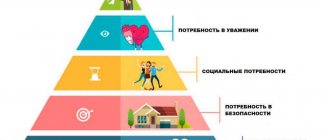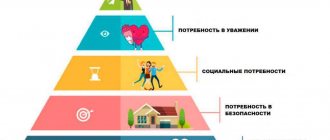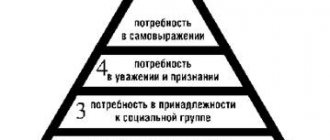Social, spiritual and material needs
The needs are so diverse that there are many classifications of them. In classical science, it is customary to distinguish 3 groups of needs: social, spiritual and material. The first place is given to material satisfaction: in clothing, housing, water, food. The means by which needs are satisfied are called material goods. These can be essential or luxury items, as well as services (consultations with a lawyer, doctor, car repair, etc.).
Spiritual needs are associated with the need for the development of the individual as a personality. They are satisfied by obtaining an education, reading books, engaging in art, and possessing information.
Through the participation of people in public and collective activities, socio-economic needs are realized: in trade unions, parties, public foundations, creative circles, and charitable organizations.
Examples of social needs
The most common types of social needs are the following:
- Need for love, friendship, family;
- The need to belong to a certain social group;
- The need to occupy some position in a social group;
- The need to comply with the rules and requirements of the chosen social group.
There is a fairly large category of people who consciously prioritize social needs over biological ones. For example, they sacrifice their own sleep or food intake in order to be able to fulfill certain social obligations and spend time with people close to them and important to them.
Social needs can be classified into the following main groups:
- Aesthetic. The need for a person to highlight some harmony, balance and beauty in everything;
- Personal. Needs that most actively manifest themselves during the stages of growing up. This includes self-knowledge, self-development and self-improvement.
- Emotional. A category of factors that reflect a person’s need to express emotions, as well as receive them from other people.
- Intelligent. An innate property of each person, which consists in a continuous process of cognition of the surrounding world.
- Creative. Finding ways to express yourself and realize your inner world.
Other classifications of needs
There are other divisions. For example, according to the types of subjects of needs, they are divided into public, collective, family and individual. Representatives of neoclassical science in economics (for example, A. Marshall, an English economist) divided them into relative and absolute, lower and higher, urgent and those that can be postponed, indirect and direct. Needs are also identified by sphere of action: communication, labor, recreation (restoration of working capacity, rest) and economic needs. Let's take a closer look at the last type.
Economic needs are part of human needs, for the satisfaction of which there must be production, exchange, distribution and consumption of services and goods. It is this type of need that is involved in the interaction between unsatisfied demands and production.
The needs of society, their types.
Needs - a lack (need) of something objectively necessary to maintain the life activity and development of a person (individual), social group, company, society. In economics, needs act as internal drivers of active economic activity.
Human needs are limitless, diverse, changeable; they can be classified according to the following criteria.
1. By subjects (carriers of needs):
a) satisfied individually (personally) ;
b) satisfied collectively (group, collective, society) .
2. By objects (subjects to which they are directed):
a) material needs; b) spiritual needs; c) ethical needs (relating to morality); d) aesthetic needs (relating to art).
3. According to the degree of satisfaction of needs:
a) Final needs are the needs of the person himself, i.e. these are personal needs. Goods that satisfy final needs are called “consumer goods.” These include food, clothing, shoes, etc.
b) Intermediate needs are indirectly related to a person. These are the needs of economic entities. Their satisfaction serves to create new benefits. Therefore, these needs are considered production needs, and the goods that satisfy them are the means of production (machines, equipment, machinery, buildings, etc.).
4. By origin:
a ) Primary needs are physiological in nature, usually innate; these are vital needs, the satisfaction of which is necessary to preserve human life (needs for food, clothing, shoes, housing, water, air, etc.).
b) Secondary needs are psychological in nature (needs for success, power, respect, leisure needs: cinema, theater, sports, etc.).
Economic needs are that part of human needs, the satisfaction of which requires the production, distribution, exchange and consumption of material goods and services. Economic needs actively influence production; they are a prerequisite, an internal motivation and a specific guideline for creative activity.
According to Russian economists, economic needs can be divided into 3 groups.
1. Material (physiological):
a) basic needs (food, clothing, housing, health);
b) luxury goods (French perfume, yacht, plane, etc.).
2. Spiritual, intellectual (education, art).
3. Social (needs for work, participation in management, etc.).
The law of increasing needs states: the dynamics of diverse needs are constantly growing in quantitative terms, but are changing to an even greater extent in qualitative terms. The range of needs of a modern person is extremely diverse, especially since human needs include not only individual needs, but also the needs of the family, social group, and work collective , population, state. The number of types of benefits, goods, services that people need is in the millions, however, their range is constantly expanding.
Maslow's theory
The theory of A. Maslow, an American sociologist (his photo is presented below), has gained great popularity in modern Western literature. All needs, in accordance with this classification, can be arranged in the form of a pyramid, in ascending order from material (“lower”) needs to spiritual (“highest”) needs.
The following types are distinguished:
- physiological needs (drinking, eating, etc.);
- safe (protected from fear, anger and pain, etc.);
- in social connections (friendships, family, religious);
- in acquiring social status (approval, recognition);
- in self-expression (realization of personality abilities).
This classification can be presented in the form of a pyramid, at the top of which there will be needs for self-expression, and at the base - physiological. Lower order needs, according to Maslow, are physiological and safety needs, and higher order needs are for social status and self-expression. Higher needs do not arise until the lower ones are satisfied.
Fromm and McClelland's classifications of social needs
German sociologist Erich Fromm classifies social needs differently. He divides them into:
- connections (a person’s desire to become part of a team or group);
- affection (showing friendship and love, willingness to exchange warmth of feelings);
- self-affirmation (emphasis on the intention to show and establish one’s importance in the eyes of others);
- self-awareness (the desire to indicate one’s individuality, to stand out from the crowd);
- guidelines (criterion of behavior based on traditions, culture and religious ideas with which a person correlates his actions).
American psychologist David McClelland divides social motives and personal needs differently, based on the characteristics of a person’s character. He identifies 3 factors:
- Power. People strive to have power and monitor the actions of others. Moreover, some go to power for its own sake, while others set as their goal the settlement of the needs of others.
- Success. This need is realized under the condition of a favorable completion of the undertaking, when a person is required to show initiative associated with risk. If the project fails, the individual will not repeat it, remembering the failure.
- Involvement. Wanting to become part of a team and jointly implement a project, people gain the trust of others and maintain a conflict-free existence during its implementation.
Interrelation and interdependence of needs
You can supplement the classification of needs by highlighting the following types: irrational and rational, concrete and abstract, unconscious and conscious, etc. But it should be remembered that any classification is quite conditional, since economic needs of one type or another are interdependent and interconnected. The material needs of people appear not only under the influence of the vital functions of the human body, but also to a significant extent under the influence of scientific, technical and economic development of society, social and spiritual guidelines. And the social, intellectual and spiritual needs specific to any social stratum and individual person arise under the influence of material ones. They largely depend on the degree of satisfaction of the latter.
Historical nature and dynamism of needs
The economic needs of society are historical in nature. The methods of satisfying them and their extent depend on the life demands and habits with which society as a whole, social strata and individual people were formed, that is, in what socio-historical conditions they find themselves. The economic needs of society are dynamic. Social progress, human improvement, intensity of information exchange - these are the factors under the influence of which requests change.
Continuous changes in the qualitative and quantitative ratio that economic needs and benefits undergo, a steady increase in the process of evolutionary development of society, is the law of increasing needs. Their change occurred at a relatively low rate, smoothly over many centuries and millennia. Today, the rate at which economic needs and goods are growing has accelerated significantly. At the same time, there is a social uniformity in their rise, and the emergence of needs of a higher order among ever larger masses of the population.
Features and classification of economic goods
They must be produced before they are used. Therefore, the ultimate goal of the production activity of any society and the basis of its life is precisely the creation of this kind of goods. Economic needs and resources, as well as various benefits, have a rather complex classification. Benefits are divided, depending on the criterion underlying them, into several groups.
- Long-term, which involve repeated use (book, car, videos, electrical appliances, etc.) and short-term, which disappear after a single use (matches, drinks, meat, bread, etc.).
- Substitutes (interchangeable) and complementary (mutually complementary). Not only production resources and consumer goods are classified as substitutes, but also transport services (car-plane-train), leisure services (circus-theater-cinema), etc. Speaking about complementary goods, we can cite as examples a chair and a table, a pen and paper, a car and gasoline, which, complementing each other, satisfy human economic needs.
- Present goods that are at the disposal of one or another economic entity, and future ones (their creation is only expected).
- Intangible and tangible.
- Private and public.
- Indirect and direct.
- Means of production and consumer goods.
The importance of social needs
Social needs have a lower priority of importance than physical needs, but they still remain of great importance for a person.
The importance of social needs is manifested in the following:
- The development and formation of each person occurs only in a social environment. A person cannot exist completely outside of society.
- The lack of social needs leads to the fact that a person becomes like an animal.
- To achieve success in society, the presence of social needs and their successful implementation are required.
Material and intangible benefits
The development of economic needs occurs in the direction of increasing consumption of material and intangible goods. The first are the result of the functioning of one or another material production (construction, agriculture, industry, etc.). These are clothing, food, cars, buildings, household appliances, sporting goods, etc.
The second (intangible benefits) exist in the form of activities: treatment, training, communal, household or transport services for the population, etc. Intangible goods are fundamentally different from material ones in that the consumption of the latter is always preceded by the process of their creation. Both in space and in time these two processes are separated. Unlike goods, the production of services at the same time acts as their consumption, that is, as a rule, there is no time gap.
Concept
Human social needs indicate that an individual cannot live alone. He craves love, friendship, and other positive feelings that appear when two or more people communicate.
Unfulfilled social needs do not lead to death, but can seriously reduce the quality of life. Therefore, it is necessary to think about how to implement them.
By the term “social needs,” psychologists understand this type of need that is satisfied not only by communication. It is important for an individual to receive assessment of his activities and feedback from other people.
This happens because a person is not only a unit of a biological species. His psyche is represented by a complex and multicomponent mechanism, which differs from that of an animal.
The individual wants to do something meaningful for the group that will give him recognition and praise. If he once received this, he strives to repeat the experience. It is the need for positive emotions that serves as the impetus for carrying out useful activities.
Psychologists believe that it is social needs that can contribute to the development of an individual’s personal sphere. It includes a person’s actions, his motivation, peculiarities of information perception, etc.
Psychologists are sure that it is social needs that force an individual to act actively. To gain recognition, he works and participates in public life.
For a full-fledged existence, a person needs to satisfy two groups of needs. The first is the need for food, drink, rest, etc. The second is the need for communication and recognition.
Public goods
Public goods are those goods that are in collective, common consumption. For example, public order, national defense, street lighting, etc. Non-excludability from consumption and indiscriminateness are the distinctive features of this type of benefit.
Indiscriminateness means that such goods cannot be provided to an individual without simultaneously satisfying the needs of other people. Non-excludability means indivisibility, that is, consumers who have not paid for their production cannot be excluded from using them. The state, acting as the producer of these goods, granting the right to non-payers to use them, uses special methods of influencing them. Producers of private goods behave differently.
Indirect and direct benefits
When characterizing benefits, a distinction is also made between indirect and direct. Direct - those that directly enter human consumption, and indirect, in contrast, indirectly. Economic goods are therefore classified as means of production and goods of consumption. The latter are used for home, family, personal and other types of public consumption. Various means of labor created by people and subsequently used in their work activities (instruments, instruments, structures, buildings, equipment, machines) and objects of labor (energy, materials) are means of production.
Now you know what social benefits and economic needs are. The economy today is actively developing and begins to produce increasingly better goods. However, new needs arise. It is probably impossible to satisfy them completely. Society's demands are constantly growing, and what was a luxury for one generation is already everyday life for another.









